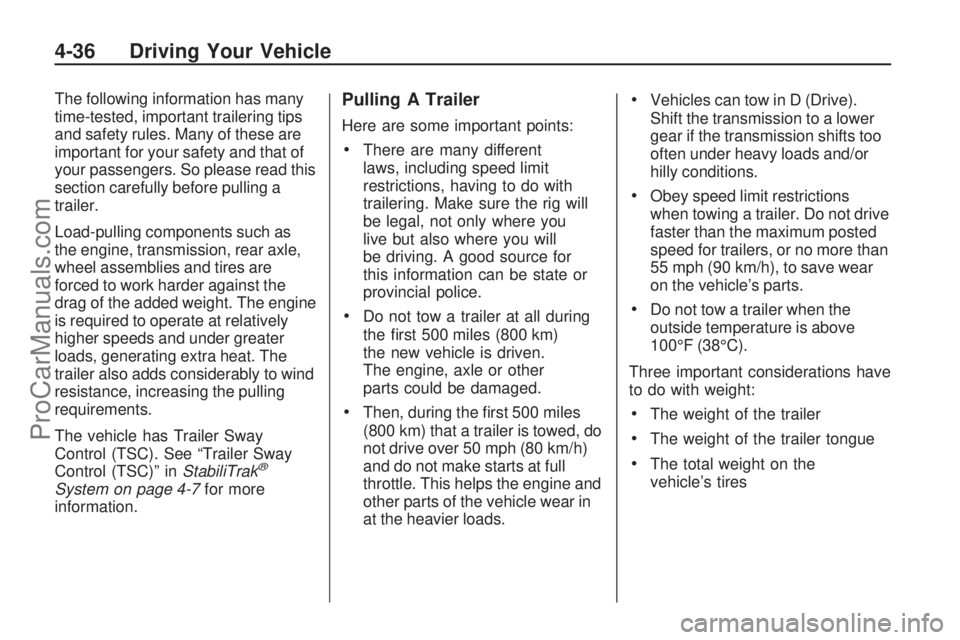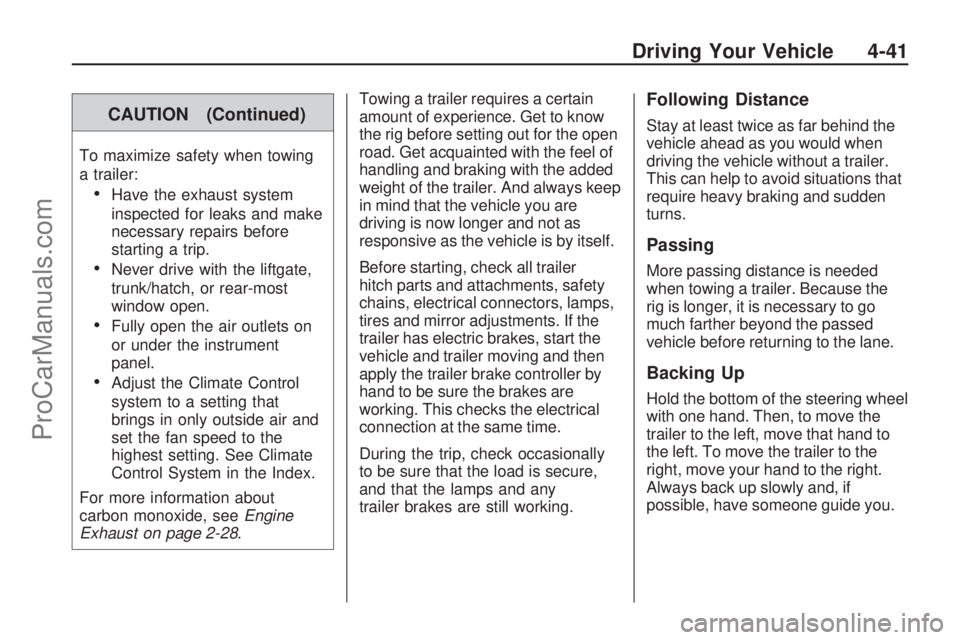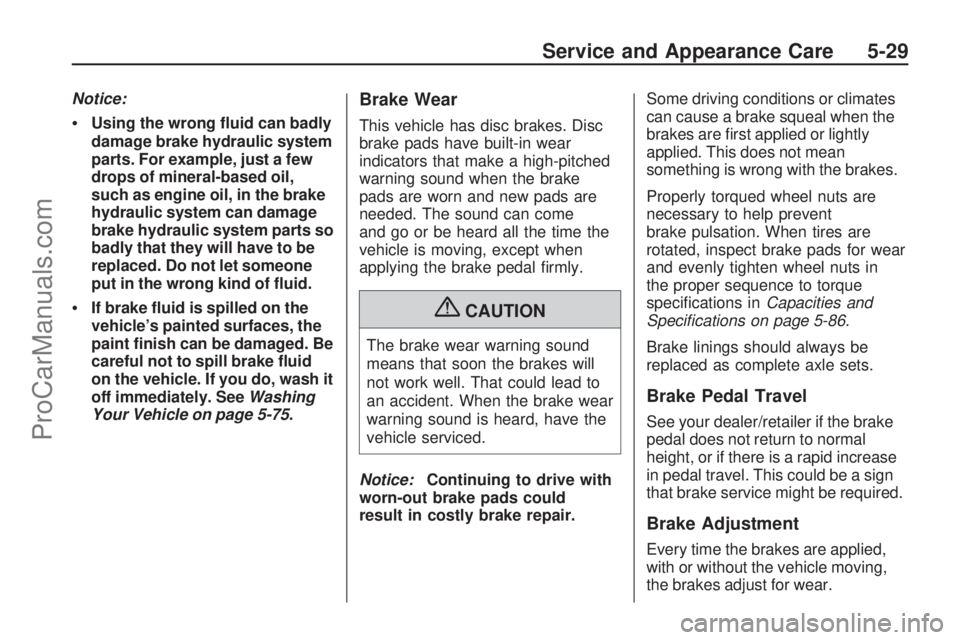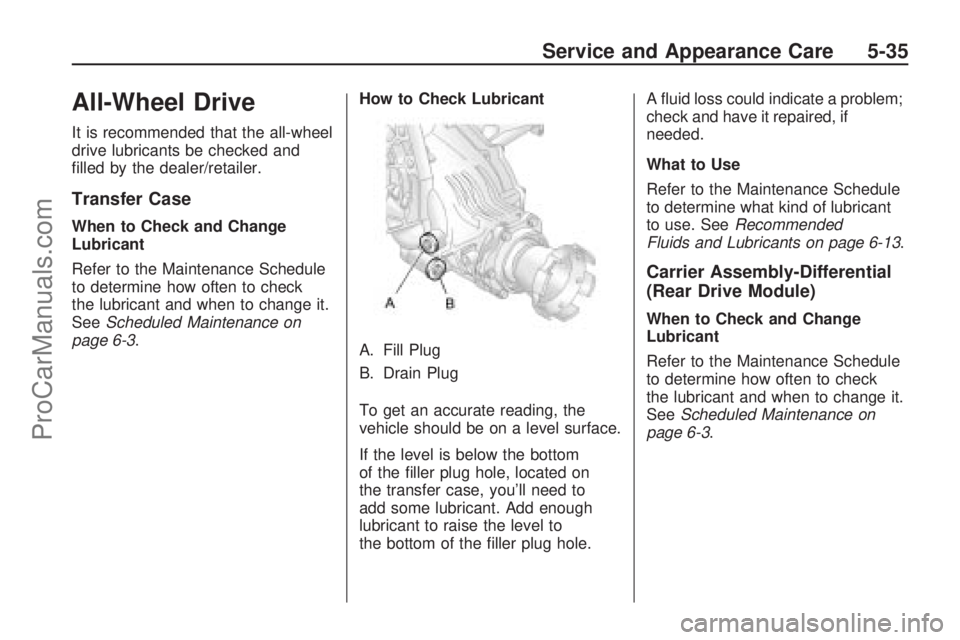wheel SATURN VUE 2009 Workshop Manual
[x] Cancel search | Manufacturer: SATURN, Model Year: 2009, Model line: VUE, Model: SATURN VUE 2009Pages: 386, PDF Size: 2.3 MB
Page 240 of 386

The following information has many
time-tested, important trailering tips
and safety rules. Many of these are
important for your safety and that of
your passengers. So please read this
section carefully before pulling a
trailer.
Load-pulling components such as
the engine, transmission, rear axle,
wheel assemblies and tires are
forced to work harder against the
drag of the added weight. The engine
is required to operate at relatively
higher speeds and under greater
loads, generating extra heat. The
trailer also adds considerably to wind
resistance, increasing the pulling
requirements.
The vehicle has Trailer Sway
Control (TSC). See “Trailer Sway
Control (TSC)” inStabiliTrak
®
System on page 4-7for more
information.
Pulling A Trailer
Here are some important points:
There are many different
laws, including speed limit
restrictions, having to do with
trailering. Make sure the rig will
be legal, not only where you
live but also where you will
be driving. A good source for
this information can be state or
provincial police.
Do not tow a trailer at all during
the �rst 500 miles (800 km)
the new vehicle is driven.
The engine, axle or other
parts could be damaged.
Then, during the �rst 500 miles
(800 km) that a trailer is towed, do
not drive over 50 mph (80 km/h)
and do not make starts at full
throttle. This helps the engine and
other parts of the vehicle wear in
at the heavier loads.
Vehicles can tow in D (Drive).
Shift the transmission to a lower
gear if the transmission shifts too
often under heavy loads and/or
hilly conditions.
Obey speed limit restrictions
when towing a trailer. Do not drive
faster than the maximum posted
speed for trailers, or no more than
55 mph (90 km/h), to save wear
on the vehicle’s parts.
Do not tow a trailer when the
outside temperature is above
100°F (38°C).
Three important considerations have
to do with weight:
The weight of the trailer
The weight of the trailer tongue
The total weight on the
vehicle’s tires
4-36 Driving Your Vehicle
ProCarManuals.com
Page 245 of 386

CAUTION (Continued)
To maximize safety when towing
a trailer:
Have the exhaust system
inspected for leaks and make
necessary repairs before
starting a trip.
Never drive with the liftgate,
trunk/hatch, or rear-most
window open.
Fully open the air outlets on
or under the instrument
panel.
Adjust the Climate Control
system to a setting that
brings in only outside air and
set the fan speed to the
highest setting. See Climate
Control System in the Index.
For more information about
carbon monoxide, seeEngine
Exhaust on page 2-28.Towing a trailer requires a certain
amount of experience. Get to know
the rig before setting out for the open
road. Get acquainted with the feel of
handling and braking with the added
weight of the trailer. And always keep
in mind that the vehicle you are
driving is now longer and not as
responsive as the vehicle is by itself.
Before starting, check all trailer
hitch parts and attachments, safety
chains, electrical connectors, lamps,
tires and mirror adjustments. If the
trailer has electric brakes, start the
vehicle and trailer moving and then
apply the trailer brake controller by
hand to be sure the brakes are
working. This checks the electrical
connection at the same time.
During the trip, check occasionally
to be sure that the load is secure,
and that the lamps and any
trailer brakes are still working.
Following Distance
Stay at least twice as far behind the
vehicle ahead as you would when
driving the vehicle without a trailer.
This can help to avoid situations that
require heavy braking and sudden
turns.
Passing
More passing distance is needed
when towing a trailer. Because the
rig is longer, it is necessary to go
much farther beyond the passed
vehicle before returning to the lane.
Backing Up
Hold the bottom of the steering wheel
with one hand. Then, to move the
trailer to the left, move that hand to
the left. To move the trailer to the
right, move your hand to the right.
Always back up slowly and, if
possible, have someone guide you.
Driving Your Vehicle 4-41
ProCarManuals.com
Page 247 of 386

Parking on Hills
{CAUTION
Parking the vehicle on a hill with
the trailer attached can be
dangerous. If something goes
wrong, the rig could start to move.
People can be injured, and both
the vehicle and the trailer can be
damaged. When possible, always
park the rig on a �at surface.
If parking the rig on a hill:
1. Press the brake pedal, but do
not shift into P (Park) yet.
Turn the wheels into the curb if
facing downhill or into traffic
if facing uphill.
2. Have someone place chocks
under the trailer wheels.3. When the wheel chocks are
in place, release the regular
brakes until the chocks absorb
the load.
4. Reapply the brake pedal. Then
apply the parking brake and
shift into P (Park).
5. Release the brake pedal.
Leaving After Parking on a Hill
1. Apply and hold the brake pedal
while you:
Start the engine
Shift into a gear
Release the parking brake
2. Let up on the brake pedal.
3. Drive slowly until the trailer is
clear of the chocks.
4. Stop and have someone pick up
and store the chocks.
Maintenance When Trailer
Towing
The vehicle needs service more
often when pulling a trailer. See
Scheduled Maintenance on page 6-3
for more information. Things that
are especially important in trailer
operation are automatic transmission
�uid, engine oil, axle lubricant, belts,
cooling system and brake system.
It is a good idea to inspect these
before and during the trip.
Check periodically to see that all
hitch nuts and bolts are tight.
Engine Cooling When Trailer
Towing
The cooling system may temporarily
overheat during severe operating
conditions. SeeEngine Overheating
on page 5-25.
Driving Your Vehicle 4-43
ProCarManuals.com
Page 249 of 386

Service and
Appearance Care
ServiceService................................5-3
Accessories and
Modi�cations.......................5-3
California Proposition 65
Warning.............................5-4
California Perchlorate
Materials Requirements........5-4
Doing Your Own
Service Work......................5-4
Adding Equipment to the
Outside of the Vehicle...........5-5
FuelFuel....................................5-5
Gasoline Octane...................5-5
Gasoline Speci�cations..........5-6
California Fuel......................5-6
Additives..............................5-6
Fuels in Foreign Countries......5-8
Filling the Tank.....................5-8
Filling a Portable Fuel
Container..........................5-10
Checking Things Under
the Hood
Checking Things Under
the Hood..........................5-10
Hood Release.....................5-11
Engine Compartment
Overview..........................5-12
Engine Oil..........................5-14
Engine Oil Life System.........5-16
Engine Air Cleaner/Filter.......5-17
Automatic Transmission
Fluid................................5-18
Cooling System...................5-19
Engine Coolant...................5-22
Coolant Surge Tank
Pressure Cap....................5-25
Engine Overheating.............5-25
Power Steering Fluid............5-26
Windshield Washer Fluid......5-27
Brakes...............................5-28
Battery...............................5-30
Jump Starting.....................5-31
All-Wheel DriveAll-Wheel Drive...................5-35
Headlamp AimingHeadlamp Aiming................5-36
Bulb ReplacementBulb Replacement...............5-39
Halogen Bulbs....................5-39
Headlamps.........................5-39
Front Turn Signal and
Parking Lamps..................5-40
Taillamps, Turn Signal,
Stoplamps and Back-up
Lamps..............................5-40
License Plate Lamp.............5-41
Replacement Bulbs..............5-41
Windshield Wiper Blade
Replacement
Windshield Wiper Blade
Replacement.....................5-42
TiresTires..................................5-43
Tire Sidewall Labeling..........5-44
Tire Terminology and
De�nitions.........................5-46
In�ation - Tire Pressure........5-49
High-Speed Operation..........5-50
Tire Pressure Monitor
System.............................5-51
Tire Pressure Monitor
Operation..........................5-53
Service and Appearance Care 5-1
ProCarManuals.com
Page 250 of 386

Tire Inspection and
Rotation............................5-56
When It Is Time for
New Tires.........................5-57
Buying New Tires................5-58
Different Size Tires and
Wheels.............................5-59
Uniform Tire Quality
Grading............................5-60
Wheel Alignment and
Tire Balance.....................5-61
Wheel Replacement.............5-62
Tire Chains.........................5-62
If a Tire Goes Flat...............5-63
Changing a Flat Tire............5-64
Removing the Spare
Tire and Tools...................5-65
Removing the Flat Tire and
Installing the Spare Tire.......5-66
Storing a Flat or Spare
Tire and Tools...................5-70
Compact Spare Tire.............5-71Appearance CareInterior Cleaning..................5-72
Fabric/Carpet......................5-73
Leather..............................5-74
Instrument Panel, Vinyl, and
Other Plastic Surfaces.........5-74
Care of Safety Belts............5-74
Weatherstrips......................5-75
Washing Your Vehicle..........5-75
Cleaning Exterior
Lamps/Lenses...................5-75
Finish Care.........................5-76
Windshield and Wiper
Blades..............................5-76
Aluminum Wheels................5-77
Tires..................................5-77
Sheet Metal Damage...........5-78
Finish Damage....................5-78
Underbody Maintenance.......5-78
Chemical Paint Spotting........5-78Vehicle Identi�cationVehicle Identi�cation
Number (VIN)....................5-79
Service Parts Identi�cation
Label...............................5-79
Electrical SystemAdd-On Electrical
Equipment........................5-79
Windshield Wiper Fuses.......5-80
Power Windows and
Other Power Options..........5-80
Fuses and Circuit
Breakers...........................5-80
Instrument Panel
Fuse Block.......................5-80
Underhood Fuse Block.........5-82
Capacities and
Speci�cations
Capacities and
Speci�cations....................5-86
5-2 Service and Appearance Care
ProCarManuals.com
Page 277 of 386

Notice:
Using the wrong �uid can badly
damage brake hydraulic system
parts. For example, just a few
drops of mineral-based oil,
such as engine oil, in the brake
hydraulic system can damage
brake hydraulic system parts so
badly that they will have to be
replaced. Do not let someone
put in the wrong kind of �uid.
If brake �uid is spilled on the
vehicle’s painted surfaces, the
paint �nish can be damaged. Be
careful not to spill brake �uid
on the vehicle. If you do, wash it
off immediately. SeeWashing
Your Vehicle on page 5-75.
Brake Wear
This vehicle has disc brakes. Disc
brake pads have built-in wear
indicators that make a high-pitched
warning sound when the brake
pads are worn and new pads are
needed. The sound can come
and go or be heard all the time the
vehicle is moving, except when
applying the brake pedal �rmly.
{CAUTION
The brake wear warning sound
means that soon the brakes will
not work well. That could lead to
an accident. When the brake wear
warning sound is heard, have the
vehicle serviced.
Notice:Continuing to drive with
worn-out brake pads could
result in costly brake repair.Some driving conditions or climates
can cause a brake squeal when the
brakes are �rst applied or lightly
applied. This does not mean
something is wrong with the brakes.
Properly torqued wheel nuts are
necessary to help prevent
brake pulsation. When tires are
rotated, inspect brake pads for wear
and evenly tighten wheel nuts in
the proper sequence to torque
speci�cations inCapacities and
Specifications on page 5-86.
Brake linings should always be
replaced as complete axle sets.
Brake Pedal Travel
See your dealer/retailer if the brake
pedal does not return to normal
height, or if there is a rapid increase
in pedal travel. This could be a sign
that brake service might be required.
Brake Adjustment
Every time the brakes are applied,
with or without the vehicle moving,
the brakes adjust for wear.
Service and Appearance Care 5-29
ProCarManuals.com
Page 283 of 386

All-Wheel Drive
It is recommended that the all-wheel
drive lubricants be checked and
�lled by the dealer/retailer.
Transfer Case
When to Check and Change
Lubricant
Refer to the Maintenance Schedule
to determine how often to check
the lubricant and when to change it.
SeeScheduled Maintenance on
page 6-3.How to Check Lubricant
A. Fill Plug
B. Drain Plug
To get an accurate reading, the
vehicle should be on a level surface.
If the level is below the bottom
of the �ller plug hole, located on
the transfer case, you’ll need to
add some lubricant. Add enough
lubricant to raise the level to
the bottom of the �ller plug hole.A �uid loss could indicate a problem;
check and have it repaired, if
needed.
What to Use
Refer to the Maintenance Schedule
to determine what kind of lubricant
to use. SeeRecommended
Fluids and Lubricants on page 6-13.
Carrier Assembly-Differential
(Rear Drive Module)
When to Check and Change
Lubricant
Refer to the Maintenance Schedule
to determine how often to check
the lubricant and when to change it.
SeeScheduled Maintenance on
page 6-3.
Service and Appearance Care 5-35
ProCarManuals.com
Page 294 of 386

Tire Size
The following illustration shows
an example of a typical
passenger vehicle tire size.
(A) Passenger (P-Metric) Tire
:The United States version of a
metric tire sizing system. The
letter P as the �rst character in
the tire size means a passenger
vehicle tire engineered to
standards set by the U.S. Tire
and Rim Association.
(B) Tire Width
:The three-digit
number indicates the tire section
width in millimeters from sidewall
to sidewall.(C) Aspect Ratio
:A two-digit
number that indicates the tire
height-to-width measurements.
For example, if the tire size
aspect ratio is 60, as shown in
item C of the illustration, it would
mean that the tire’s sidewall is
60 percent as high as it is wide.
(D) Construction Code
:A letter
code is used to indicate the type
of ply construction in the tire.
The letter R means radial ply
construction; the letter D means
diagonal or bias ply construction;
and the letter B means
belted-bias ply construction.
(E) Rim Diameter
:Diameter of
the wheel in inches.
(F) Service Description
:These
characters represent the load
index and speed rating of the tire.
The load index represents the
load carry capacity a tire is
certi�ed to carry. The speed
rating is the maximum speed a
tire is certi�ed to carry a load.
Tire Terminology and
De�nitions
Air Pressure:The amount of air
inside the tire pressing outward
on each square inch of the tire.
Air pressure is expressed in
pounds per square inch (psi)
or kilopascal (kPa).
Accessory Weight
:This means
the combined weight of optional
accessories. Some examples
of optional accessories are,
automatic transmission, power
steering, power brakes, power
windows, power seats, and air
conditioning.
Aspect Ratio
:The relationship
of a tire’s height to its width.
Belt
:A rubber coated layer of
cords that is located between the
plies and the tread. Cords may
be made from steel or other
reinforcing materials.
5-46 Service and Appearance Care
ProCarManuals.com
Page 300 of 386

Your vehicle has also been equipped
with a TPMS malfunction indicator
to indicate when the system is not
operating properly. The TPMS
malfunction indicator is combined
with the low tire pressure telltale.
When the system detects a
malfunction, the telltale will �ash for
approximately one minute and then
remain continuously illuminated.
This sequence will continue upon
subsequent vehicle start-ups as long
as the malfunction exists.
When the malfunction indicator is
illuminated, the system may not
be able to detect or signal low tire
pressure as intended. TPMS
malfunctions may occur for a variety
of reasons, including the installation
of replacement or alternate tires or
wheels on the vehicle that prevent
the TPMS from functioning properly.
Always check the TPMS malfunction
telltale after replacing one or more
tires or wheels on your vehicle toensure that the replacement or
alternate tires and wheels allow
the TPMS to continue to function
properly.
SeeTire Pressure Monitor
Operation on page 5-53for
additional information.
Federal Communications
Commission (FCC) and
Industry and Science Canada
The Tire Pressure Monitor System
(TPMS) operates on a radio
frequency and complies with Part 15
of the FCC Rules. Operation is
subject to the following two
conditions:
1. This device may not cause
harmful interference.
2. This device must accept any
interference received, including
interference that may cause
undesired operation.Vehicles with TPMS operate on
a radio frequency and comply with
RSS-210 of Industry and Science
Canada. Operation is subject to the
following two conditions:
1. This device may not cause
interference.
2. This device must accept any
interference received, including
interference that may cause
undesired operation of the
device.
Changes or modi�cations to
this system by other than an
authorized service facility could void
authorization to use this equipment.
5-52 Service and Appearance Care
ProCarManuals.com
Page 301 of 386

Tire Pressure Monitor
Operation
This vehicle may have a Tire
Pressure Monitor System (TPMS).
The TPMS is designed to warn the
driver when a low tire pressure
condition exists. TPMS sensors are
mounted onto each tire and wheel
assembly, excluding the spare tire
and wheel assembly. The TPMS
sensors monitor the air pressure in
the vehicle’s tires and transmit the
tire pressure readings to a receiver
located in the vehicle.
When a low tire pressure condition
is detected, the TPMS illuminates
the low tire pressure warning light on
the instrument panel cluster.The low tire pressure warning light
comes on at each ignition cycle
until the tires are in�ated to
the correct in�ation pressure.
The low tire pressure warning light
may come on in cool weather
when the vehicle is �rst started, and
then turn off as you start to drive.
This may be an early indicator
that the air pressure in the tire(s)
are getting low and need to be
in�ated to the proper pressure.
A Tire and Loading Information
label, attached to your vehicle,
shows the size of your vehicle’s
original equipment tires and
the correct in�ation pressure for
your vehicle’s tires when they
are cold. SeeLoading the Vehicle
on page 4-28, for an example of the
Tire and Loading Information
label and its location on your
vehicle. Also seeInflation - Tire
Pressure on page 5-49.Your vehicle’s TPMS system can
warn you about a low tire pressure
condition but it does not replace
normal tire maintenance. SeeTire
Inspection and Rotation on
page 5-56andTires on page 5-43.
Notice:Liquid tire sealants could
damage the Tire Pressure Monitor
System (TPMS) sensors. Sensor
damage caused by using a tire
sealant is not covered by your
warranty. Do not use liquid tire
sealants.
TPMS Malfunction Light
The TPMS will not function properly
if one or more of the TPMS
sensors are missing or inoperable.
When the system detects a
malfunction, the low tire warning
light �ashes for about one minute
and then stays on for the
remainder of the ignition cycle.
Service and Appearance Care 5-53
ProCarManuals.com